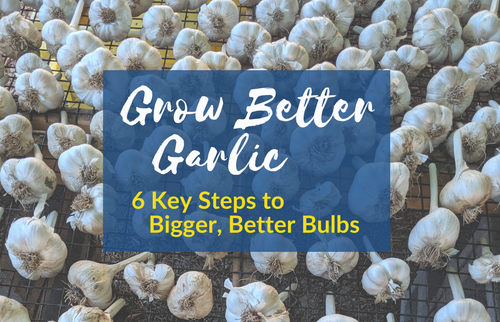
Garlic is one of our favorite crops to grow; it's fun to plant the cloves in the fall and know you've got one of your first summer crops already lined up. However, if you want to maximize your yield—and your delight at harvest time—it takes some attention to detail, as garlic plants are quite sensitive to the particulars of their cultivation. Want to grow better garlic next year? Read on for tips!

One reason that our certified organic and sustainably grown seed garlic begins shipping in September is that we think, when it comes to garlic planting, the earlier the better. While you can plant the cloves anytime before the ground freezes solid and still get satisfactory results, the earlier you plant, the more time the cloves have to develop a robust root system over the winter. This root system will largely determine your potential maximum garlic size, so the earlier you get them in, the bigger your heads will be next July.

Garlic is an exceedingly hungry crop; it demands the most nutritious soil you can provide—not just next season, but right out the gate this fall. Overloading your garlic bed with compost and organic fertilizer in the fall is a great idea; then apply a liquid fertilizer (compost tea or a commercial product) during the cool-soil period next March/April, as nitrogen is slow to become available to plants when the soil is chilly—but that's right when garlic needs it to fuel its heaviest-growth season.

Each winter is different, and during some years the freeze-thaw cycle can be very disruptive to your garlic beds. It's a good idea to plant deeply in the fall and then examine your beds mid-winter to be sure that cloves aren't being heaved out of the soil by frost; it's surprising how readily this can happen when conditions are right. Thaw periods are when this is most likely, so take advantage of those milder days to scout your field for ejections. If any are popping up and out, do your best to re-seat them; note that this can be tricky if a layer of freeze is below the soil surface. So you may need to apply a layer of mulch or potting soil and cross your fingers.

Like most alliums, garlic wants two seemingly contradictory conditions: well-draining soil and nearly constant water throughout its growth cycle. Raised beds that are actively irrigated are just about perfect to achieve this, and garlic grown by our customers in raised beds can compete favorably with garlic produced by seasoned commercial growers precisely because of these ideal conditions. Drought during the months of April, May, or June is highly detrimental to garlic growth, so be sure you're prepared to provide irrigation early in the season.

Garlic cannot tolerate weed pressure. Even seemingly small and innocuous weeds diminish garlic's potential—and quickly. So, cultivate your garlic patch thoroughly and regularly; save your more freewheeling weeding style for your squash bed. A kana scraper is a great tool for this. Or consider mulching with straw! It can be a labor saver and will help keep water in the soil during dry spells.

One of the delights of growing your own garlic is the abundance of scapes that are available for harvest from late May through late June. But these are not only a delightful early bonus crop; they are the result of an essential pruning tactic. Quick and efficient removal of the scapes prevents the garlic plants from sending energy into bulbil production (these are the tiny propagation material that form at the end of the scape). This ensures that all available energy in the plant will go into sizing up the bulb and is the last real intervention possible at that late stage of the growing process.

